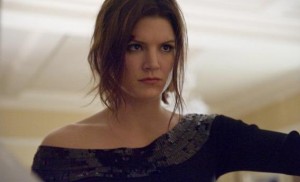Digital Divide: May 2012

There’s something about hearing dir-ector Steven Soderbergh making a straightforward action film that immediately sent up a few red flags. First and foremost is the fact that Soderbergh has never made a straightforward film in his life.
No matter what genre he’s dabbling in, whether it be globe-hopping social drama (Traffic, Contagion), quiet morality tales (The Underneath, Out Of Sight), or his “Hollywood” flicks (the Ocean’s films), Soderbergh always seems to inject just a little twist in the narrative. Whether it’s a subtle character flaw or something as simple as holding a second or two longer than is comfortable on a reaction shot, there’s always an item that elevates his films just a little higher.
Unfortunately, introspection doesn’t work that well when bullets are flying and skulls are getting cracked.
The twist for Haywire is the gender reversal. Instead of the usual bad-ass male gun-for-hire out to right the wrongs and clear his name, we get former MMA fighter Gina Carano as the bad-ass gun-for-hire out to right the wrongs and clear her name.
Of course, it’s not really a twist at all, since there is a fairly decent roster of women in action flicks. But unlike, say, Angelina Jolie in Salt or Zoe Saldana in Columbiana, Carano is the first one who you actually have no trouble believing could kick someone’s ass without so much as getting a run in her tights.
Soderbergh hedges his bets by surrounding his first-time star with a cast of heavyweights. Michael Fassbender, Ewan McGregor, Bill Paxton, Channing Tatum, Antonio Banderas, and Michael Douglas all have a hand in the double (possibly triple) crossing. And while Carano isn’t going to be swiping any roles from Cate Blanchett anytime soon, she fares decently and holds her own. After all, she’s not getting paid to do Tennessee Williams, she’s getting paid to break bones.
Unfortunately, after about an hour the film hits a brick wall, and Soderbergh has no idea how to restart. Surprisingly, he’s not served well by writer Lem Dobbs, with whom he collaborated on the infinitely superior The Limey. Dobbs’ script becomes hazy and unfocused, allowing for long sections of downtime on the way to a jarringly hasty ending.
The Blu-ray features a smashing-looking film transfer, and little else. There are extended segments of Carano’s fight training, as well as brief interviews with the men of the cast (sans Douglas) and little else aside from a digital copy.
The Sun Came Out: The Making Of The Album 7 Worlds Collide
Cinema Libre
In 2001, Crowded House’s Neil Finn put together three charity concerts called 7 Worlds Collide, which included Eddie Vedder, Johnny Marr of The Smiths, Radiohead’s Phil Selway and Ed O’Brien, and Lisa Germano.
In 2008, Finn assembled another lineup to raise money for the poverty relief organization Oxfam, this time with more guests, and also to record an album as well as the live gigs.
With the exception of Vedder, everyone from the 2001 gigs were back, plus Wilco’s Jeff Tweedy, Glenn Kotche, John Stirratt, and Pat Sansone, as well as KT Tunstall on board.
The Sun Came Out follows the group and their families in and out of the studio as they cull together 10 songs in three weeks.
The end result is, predictably, disjointed — as you would expect from a project with as many disparate voices working on their own songs. Yet it holds up as more than the sum of its parts.
If you live for fly-on-the-wall looks inside recording studios and into the creative process, Sun would be for you. If, like most people, you only hold a passing fancy for the tweaking and tuning of studio knobs, it probably goes on a bit too long.
However, the inclusion of the 2001 concert helps a lot.
— Timothy Hiatt
Category: Columns, Digital Divide, Monthly











